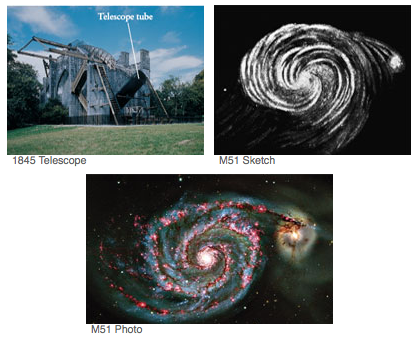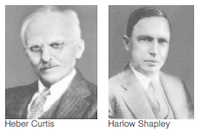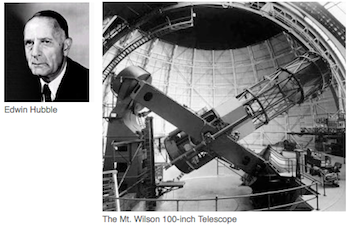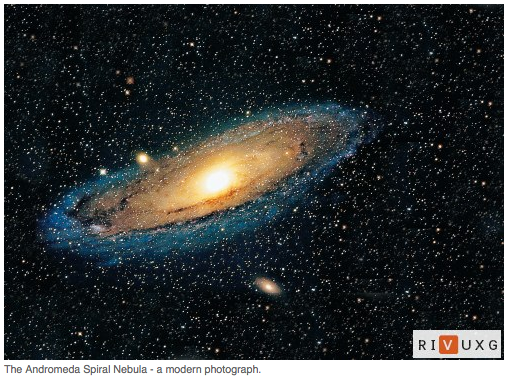Chapter
24. A Universe of Galaxies
24.1 Introduction
AstroTutorials
true
To advance to the next page of the tutorial you need to submit every question; currently you have not finished all the questions on this page. Leaving a tutorial page without submitting all the questions results in you receiving no grade in the gradebook.
true
Author: Grace L. Deming, University of Maryland
Editor: Beth Hufnagel, Anne Arundel Community College

A spiral nebula in Pegasus
The goals of this module: After completing this exercise, you should be able to:
- Summarize the controversy debated by Shapley and Curtis in 1920.
- Explain how Edwin Hubble resolved the problem of spiral nebulae.
- Describe Hubble's galaxy classification system.
In this module you will explore:
- How astronomers determined that the Milky Way Galaxy is one of many galaxies in the universe.
- How astronomers classify galaxies based on appearance.
Why you are doing it: Less than 100 years ago, most astronomers thought that our Milky Way Galaxy was pretty much all there was in space. They had no idea of the size and extent of the universe. Observers noticed and classified objects like this spiral shaped object shown in the picture above as "spiral nebulae". Look carefully and you will see several smaller spirals and football-shaped fuzzy objects as well. Gradually, observations made with bigger and better telescopes and new instruments began to reveal that we live in a universe dominated not by the Milky Way's stars, but by other galaxies.
24.2 Background
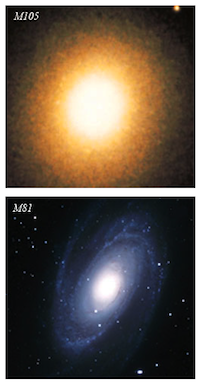
Two "nebulae" from Messier's catalog
During the 1700s-1800s, astronomers began to view objects at ever increasing distances with bigger and better telescopes. Objects with similar characteristics were grouped together in an attempt to understand their true natures. Between 1758-1782, the French comet hunter Charles Messier assembled a catalog of fuzzy appearing objects, so that he wouldn't confuse them with a real comet. These objects today are still referred to by their number in his catalog, but are classified as star forming regions like the Orion Nebula, Messier 42 (M42); planetary nebulae like the Ring Nebula, M57; star clusters, like the globular cluster in Hercules, M13; and the Crab Nebula supernova remnant, M1. Some of Messier's objects displayed a spiral or oval shape, like M81 and M105 shown to the right.
Astronomers simply drew what they saw through a telescope, since they had no cameras to take a picture or instruments to spread faint starlight into a spectrum. Lord Rosse used the large telescope shown below to look at M51, the Whirlpool Nebula. Note that his sketch is accurate when compared to a modern photograph. (Fortunately, artistic ability isn't a requirement for modern astronomers!)
But in the mid-1800s, Lord Rosse and other astronomers had no way of measuring the distances to the objects in Messier’s catalog. Actually, the distances to stars were just starting to be measured with the first parallax determined in 1831.
Question
24.1
4d43ShDqh82DgGgsQr65dtIvoeRBVEXKkBDh6PptjL0t866EROUtQUBHmEOA7k4UlG2qa0AAmhA+ErDN3X1yzgIE5c2q1G4LUXfGNcs2Gssb+IsPEKC0ksYPyl6SN+4QqmtuInDuGTwnIKcEGfGRWdSInP8K3/dzgpjHigN0P8ziXD8NoN0peDUDGUH5wSk1uK8Il2HGOOIJEu7qapyeQwzP44TuLpop
3
Try again. In the mid-1800s, there were no instruments like a spectrograph that could be used with a telescope.
Correct. The first spectrum was taken in 1872. So without the ability to make more than visual observations, questions remained about M51 and the other strange spiral shaped nebulae. What were they? Were they made of gas, stars, or some unknown luminous fluid like that found in fireflies? Were they close or far?
Incorrect. The first spectrum was taken in 1872. So without the ability to make more than visual observations, questions remained about M51 and the other strange spiral shaped nebulae. What were they? Were they made of gas, stars, or some unknown luminous fluid like that found in fireflies? Were they close or far?
24.3 A Universal Debate
By the early 1900s American astronomer Harlow Shapley had earned respect by estimating the size of the Milky Way Galaxy using the distribution of globular star clusters. In Shapley's opinion, the spiral nebulae were small and members of our galaxy. An opposing view offered by another American, Heber Curtis, was based on an earlier idea by the German philosopher Immanuel Kant. In this "island universe" model, the Milky Way was only one huge collection of stars; there were others. Curtis proposed that these spiral nebulae were each a huge rotating system of stars, similar to our Milky Way Galaxy.
The Shapley-Curtis debate took place in 1920 at the National Academy of Sciences in Washington, D.C. Shapley argued that the Milky Way was the main entity in the universe, the Sun was not located at the center of the Milky Way, and that the spiral nebulae were nearby clouds of gas. Curtis took the position that the Milky Way was a small galaxy, the Sun was located near the center of our galaxy, and the spiral nebulae were other galaxies like our Milky Way, but far away.
Question
24.2
/EvHWGU+6dGFd8kSTAcmouZArPFWqLMZDwCWjvnQ9FZn875U9+xDMRqtcvNePh+bDWlQcJYUdsaq2tjiZxtwtcQQujUAVKJJJVBc9TFoJggvn3Db3CDw30Ju9s/rDakXdv98Oq9MyfH81D/r8tkW9a7PAgm6rU68eAtcUA==
3
Try again. Spiral nebulae in Shapley's model were small and nearby gas clouds inside the Milky Way.
Correct. Shapley envisioned our Milky Way Galaxy as the main structure in the entire universe. At the debate's conclusion, there was no declared winner, but we know today that both of them had part of the answer. Shapley was correct about the Sun's location in the galaxy, but wrong about the nature of the spiral nebulae. Curtis was right that our galaxy is one of many, but he incorrectly placed the Sun at the center of the Milky Way Galaxy.
Incorrect. Shapley envisioned our Milky Way Galaxy as the main structure in the entire universe. At the debate's conclusion, there was no declared winner, but we know today that both of them had part of the answer. Shapley was correct about the Sun's location in the galaxy, but wrong about the nature of the spiral nebulae. Curtis was right that our galaxy is one of many, but he incorrectly placed the Sun at the center of the Milky Way Galaxy.
24.4 The Mt. Wilson Telescope
The next big breakthrough in resolving the Shapley-Curtis debate involved a new telescope located in the mountains near Los Angeles and the astronomer Edwin Hubble, both shown to the right. In 1917, the new Mt. Wilson telescope saw its first light. Its huge mirror, 100-inches across, allowed astronomers to collect light more efficiently than any other telescope for the next three decades. Hubble, for whom the Hubble Space Telescope is named, was one of the first astronomers to regularly use the Mt. Wilson 100-inch Telescope. He saw things that no one had ever seen before!
Hubble photographed the spiral nebula shown below, located in the constellation Andromeda. In 1923, he identified a Cepheid variable star embedded in the nebula. This was exciting because the distance to these stars can be calculated. Hubble found more Cepheids, and he started observing these stars regularly to determine the period of variation for each one.
Henrietta Leavitt had developed a period-luminosity relation based on Cepheid variables she had studied in the Magellanic Clouds. The period-luminosity relation is shown below.

The Period - Luminosity Relation for Cepheid Variables
Question
24.3
IW5IrP0NubbQ8lYGyVr8q0dRKlnanagsNi8YiYbD7AmUluPU2xlKLdfaZVRjANXtQbrtvWt8Ehf9tWfUTYmV631jLHYyJ6G4ZKVYyOBZHCF3hH9ixYEnhVEtduS0xwNddqGZFMXggJDyVqh98nNw560xl+Gj/aLNJddfqfmIITSQbGJGCcXRppdlAcYuPEMO6qDISzeCNAs9T6bApubAllMEQLmVUUcjM+1fwvAbHHKBiTLInlGS8Jey4J9A0pxvi1ZQkOx6QI26D5+VyExO776CkmVB7FQOH1iWPoYEycT1NeijQfJVYWjZBk1xTvOurhXelJPta94eugE0GuNWh8d4Zwb11UpObip6yw==
3
Try again. Look carefully at the points on this graph. Locate the Cepheids with periods of 50 days. Read off the luminosity on the vertical scale.
Correct. You can use the period to estimate the luminosity of Cepheid variables from the graph shown above. Then, since the energy spreads out with distance and the star looks dimmer the further away the observer is, you could go on to calculate its distance.
Incorrect. You can use the period to estimate the luminosity of Cepheid variables from the graph shown above. Then, since the energy spreads out with distance and the star looks dimmer the further away the observer is, you could go on to calculate its distance.
Summary
The Cepheid variables that Hubble observed in the Andromeda Spiral Nebula were very faint but had long periods of a month or more. The distance that he calculated placed this system of stars well outside the boundaries of our Milky Way Galaxy. The Andromeda Spiral was another galaxy, very similar to our Milky Way Galaxy! Modern measurements place the Andromeda Galaxy at a distance of 750 kiloparsecs.
24.5 A Universe of Galaxies
Hubble's determination of the distance to the Andromeda Galaxy supported the "island universe" hypothesis. A few Cepheid variable stars in other galaxies were studied by Hubble, and gradually it was accepted that the other spiral and football shaped objects in Messier’s catalog were indeed also galaxies. As scientists often do when something new is discovered, Hubble started classifying galaxies based on their appearance.
Observe the characteristics of these three galaxy types.
24.6 Hubble's Tuning Fork Diagram
Hubble arranged his galaxy types in the "Tuning Fork Diagram," which is shown below. When he first proposed this arrangement, Hubble thought that one type of galaxy naturally evolved into another type over time. Today we know that galaxy evolution is more complicated.

Hubble's Tuning Fork Diagram
Question
24.4
plXsOyA/TcdNzusR3gSvA8sNIXvSDAxibfSy5ddcXQvMoHsQ7PCgkn5iZWVGV5jSvIeDqUdwuI0SxmoWcqMGO+/V/v7+/yl+7KSgHFfnaH3GgCEbVZ4EdsZ85ktIzqad2X4CZIE+SDx15wmNPWI/yOzZ1qA4VYLyqJMGZAAUIW8uoDoA8NwDPQ==
3
Try again. There are normal and barred spirals.
Correct. Some galaxies have an extended central region that resembles a bar, so they are called "barred spirals". The small letters a, b, and c designate the degree of openness of the spiral arms. Elliptical galaxies have a number that indicates their degree of "flatness" with E0 galaxies being round and E7 galaxies shaped like footballs. The S0 or SB0 galaxy types are called lenticular galaxies, which have a smooth disk with no spiral arms.
Incorrect. Some galaxies have an extended central region that resembles a bar, so they are called "barred spirals". The small letters a, b, and c designate the degree of openness of the spiral arms. Elliptical galaxies have a number that indicates their degree of "flatness" with E0 galaxies being round and E7 galaxies shaped like footballs. The S0 or SB0 galaxy types are called lenticular galaxies, which have a smooth disk with no spiral arms.
Summary
We know today that our Milky Way Galaxy is one of billions of galaxies in the universe. To honor Hubble’s contribution to the modern view of the universe as a vast structure filled with galaxies, NASA named the first orbiting Great Observatory (out of four) in his honor. Edwin Hubble died in 1953 and the Hubble Space Telescope was launched in 1990.
24.7 Quick Check Quiz
Indepth Activity: A Universe of Galaxies
Question
24.5
IV4yBCVLa7lonsyInZUzmrbf1qIBIt/W4wloEn5hayDIf6gThp1RY8wZljSkzWwVN6K2y39+ncTXKDTEH7jwRtM7nA5p7YA1H+2SdAw2BettpJPDDhdRyYi6AtYAhrS9EQoMh1TxkZnd+Z72ETD797R61GX6xucl7PpNkueWkH5wLDM09ADABBLMXAfvp9tllHt4T9B6CoCOL5NYnYx7G1Snwluw4dqYj2i/8BZV6xg1D75Bb2BVe+F71r+Io58olNWHyiPYxlbyzPCOnAo30R193aNgYFeo3/wrXGDY5MuKDSF7aqvJohd3GnAzay0xXc9I1zISyGaUIpuH6vIhSURL6xdewhTbM3BqMn6nvF94t3oBY1vH6YRTjp7GwXO1jGysRxLM8n63UznV7D6zhPxHyGbDrdEk0umdyMo/ZtSYQSJMwc7kr/lj7TuZY7gcFETTxQ1UR1P5GQakoX0GK5RXHJk=
Correct. Edwin Hubble used the 100-inch Mt. Wilson Telescope in California to study galaxies. The Hubble Space Telescope is named after Edwin Hubble.
Incorrect. Edwin Hubble used the 100-inch Mt. Wilson Telescope in California to study galaxies. The Hubble Space Telescope is named after Edwin Hubble.
Question
24.6
qTCvnyX/usZqf+QdoD8OAiNV8h/T5ITLRzrXsqIKZHWHhTwblH8FSrplTRATbaoILeXFxZRA+3bygBnmNv1i67ai2tMVZjKHAiz/hK7v3IGbHM4HXuomYY0+rUA8+f8LMsmkNo+kq4nINKPqGB9RebXnechhwJdrls0W3yPxkQZPedig0ITy6MHuKULN9PcIYMatyV2Ihz2sphmEpDXBjmzFW0zr6v7B4EJDWEWUfjCqJ1qGcS8QJxIPjwxM2ega+809KQCQfY3mwyy0SYXTHQ6IpQ1miyd5Wan6eZs+p/ly0G9dwB7kxpxjjZ8YqbaEoq91gmMR8lx8C/zChrLST/ZC73vGiWPiCxiodX2LNyveV1zu6bKw12NZnjlnnDSGMWquN6Tjk1qOpapu
Correct. There are three major types of galaxies that look very different. Hubble galaxy types include spirals, ellipticals and irregulars.
Incorrect. There are three major types of galaxies that look very different. Hubble galaxy types include spirals, ellipticals and irregulars.
Question
24.7
rtV9h3YqaL0Y+Sli/FW16QkPpnVLidG7UuauSW9CObA0cFL0DSggC7gs/eobDE3zYUvj26NDlzLA+XSgNsyjaNiPRQ1TqLe51HwjIJr350XqYCadOvS0MOXQqcV1BvWHAeRz+3gQrb1XQZ9FhXOSG+CQWypVU3OsAvyDRLL5BIx9RblVikQrZq5P3d9KgRkgwod9+euo81+lxI5MfzZbqMSc414fggfgDBInni6jF6GAyIzPkffLbfa5hYnXe2ZEO3GexWYUYIOzUj/G9cQInEJiAJ6qh8zuAfi47T92mn8XfN1LmY6BQVN+q68=
Correct. Some galaxies have an extended central region that resembles a bar, so they are called “barred spirals.”
Incorrect. Some galaxies have an extended central region that resembles a bar, so they are called “barred spirals.”
Question
24.8
9e/ISEzOSLvI49Qpk0ZfmRAOwxRmFQCCouV0SDpdSFBdToQswjbg+etel1yaAQzK3sgT62P3k4z6PMA40nJnDLn3PDA9sqtk5cGk3RLhgK9f9dJXERXCo1st7poExB+sIutmYXL9XCRvMSyAuVukaoXOjuz1BVDe+G8K+sY9/511DwGtzBSUkhhFohWIr/wjJVTlw+Q3higXmryZnVB0npK/lVh3aME2FecORv6jCDlcQXxjDxCngx++8TYCugQVM8/29R/Iq4ozJHwTEy2Uwg==
Correct. Elliptical galaxies have a number that indicates their degree of “flatness,” with E0 galaxies being round and E7 galaxies shaped like footballs.
Incorrect. Elliptical galaxies have a number that indicates their degree of “flatness,” with E0 galaxies being round and E7 galaxies shaped like footballs.
Question
24.9
r1KR6X9B7DNWUVO/3Qr7D1KDg4fmGn8LsIjv3v2xGfcmbqKBM7mAyZpn7XUxEz/BFLeOt+HoP/ridq4ZjbjE9zrNWwVucK3MQJtNU9btRqJ2cnR8pidoYk7lUXb3j9dKHuw6wR2ogxmr8o9d4oxTpfj8D4+h/lOWzyzSgQod0iZhqRU+hp3FRHs+KHJ/OLfPuRjy/QmBWXv5/xqIq+AlqoWRqwcJ1O9A5kquJDxa8oXpqw3XMERXX7QKjvew9oP5TFOvdw1pDzxfRR5vGRoAZZh0GbzViiNBPdCafuXM8ZSX1nPtvlS+DGovbjT1C0/gUULUsD9/1rU1AWOHATHlvlDdfjWW83//sAhhEcA3IPw+C2Jm+gR/8pW36nFY3mcSo95fuUDJxn/3FaEye/kzIb/tlcdztW+srJBWjdm3IZ/iNSWlP3L2Uyg1yN7nzcWFcXl3pabmpvL+wTOmtxIkG21yQgl2eb2z3UAJ6zXFrcW3lkZ9Q/MoZvMK4x0JRkF/90C16QHIbiBJGIu0wLOiJAoPylgLTwSpCWiEouXW6fH97IU9gFwd0GeBkWCtj5BlhVEVEdmSLwM3RxlbphYr0gLT4VXXxBYJgj6UmET03kHFhTHrqlHzJOR/C2TYPKXoaTGb9feu3UVJHV/5410NqaaESmVSl5cYIIv+AhFnvXBYgfxfjyTemOiklUlYPRO+DZ3ln1ze/oG6dLGLYF1gNrJi9nJHuv4zJBqBT9tDEASkDAa6RPw7Xf8rwEzO8nvDXfk8vzrk6X+tg5ewdcYL//RUX8lN2wlblEjGsnBNmABEfLsK8JIo60Hkm0DQgAsm
Correct. The Cepheid variables that Hubble observed in the Andromeda Spiral Nebula were very faint but had long periods of a month or more. The distance that he calculated placed this system of stars well outside the boundaries of our Milky Way Galaxy.
Incorrect. The Cepheid variables that Hubble observed in the Andromeda Spiral Nebula were very faint but had long periods of a month or more. The distance that he calculated placed this system of stars well outside the boundaries of our Milky Way Galaxy.
Question
24.10
K6WUv6hFxekQ340zl06RVBQZl0v8FJ2569RR2ID4dw3SXmX+ExSGfdicJoI3n9HoZhTJsuJEQ75RMJa7fzTNyZ/UkVE9yVqj6i5s0J1Eu3ggAYuQgJNt0P2m4jWuS6v8TnbyhV5zC+jFkPkek+fKyjIJut3o9tD6XN/8gQzQBOOy4I/wlYj80zkrWFoLaU64NA3d6idhJ7RV4kliStfpyMZDNVUSccpe3DsA8VzcxNf2AbSaimBlLTBPyOejKSmuWmszey6xUVMoco6D4eKCEmWf2yHgPcrg0En+Nbk+wWoYrWxkKpYSAmLuC2LmWAFHQqdtQL2njTpG0Kn8LgcWkW+W8uLp8HmgPRO+bmWAqVXSUf3I+2DySr9yn28fCpwIjfjrKERNTJolRy/E
Correct. At the debate’s conclusion, there was no declared winner, but we know today that both of them had part of the answer. Shapley was correct about the Sun’s location in the Galaxy, but he was wrong about the nature of the spiral nebulae. Curtis was right that our Galaxy is one of many, but he incorrectly placed the Sun at the center of the Milky Way Galaxy.
Incorrect. At the debate’s conclusion, there was no declared winner, but we know today that both of them had part of the answer. Shapley was correct about the Sun’s location in the Galaxy, but he was wrong about the nature of the spiral nebulae. Curtis was right that our Galaxy is one of many, but he incorrectly placed the Sun at the center of the Milky Way Galaxy.
Question
24.11
hATxKCLTnc8Lv7aEDNbNn92XBl+/VeKrIJTSogTuLJcSBYWPj0Y3t2/e9lzYTd9G2tA6u9pp7TucvbC01DgjnKdY7OUjTeURQdtiYcvqydFUoEN4+rnthIPGT8aKjP/5uiCpUb242lZVqHF84w6TAY7Xwi8xu66N0N7hqRFBgZK05ycEtDGl4Tsr/VVLTYd3ZaCWpAdRlrGlVGSgsgHZPlWaEPzT2gKOCvn5yUvOgeJf74BsLneWQGLgDRb6RJktIwYqN8LwEdV5YjtPhLgo5DWMK0yUcMzd0Fng1FukkyTzL+LprF+paZJyh/qRjZy+2BGvIbso7GQg9YqTc+fI1cUPpzZItyQBYRzPyPG/MeNb/HcOhYOUsHiXsh0=
Correct. We know today that our Milky Way Galaxy is one of billions of galaxies in the Universe.
Incorrect. We know today that our Milky Way Galaxy is one of billions of galaxies in the Universe.
Question
24.12
xuq6u0p+sZ2T6Ce1VarapDN/EEm37IyOENvLRs6GqHdfu8cdkVItHyTwMPVyIOW7HCGRxchUMkURAZSYE1W3gZ1ZcEko5AzwHUxioK+J43gfY8tWWoaXy5bCTvCR+xA25PtJPzpr4EsxL5vapEpLDY6BnuqTXbaTd3gFXWGFrF+FlHsY9io06Oz8Pps8vIReHkaHb9uW8TNG86wfjuB+LUa2H4TXUp6Zqn9N4MsPU+/8G3reckBPurEoF068dnCKRycyfTHI7YTOMyz93w8Jt04Q27uLTEXXgSTZYEJVOmB3EV0K9NwyVtvoM1K+eFD0KZpjh1wsKeBxtaDgHxA/xBgim/dDU+F73Hb36wRAiGvHD3Z+65t4zj5uxXv0BhVjGCM2Lbi5IUaMw3OrLiMitUUFDyuXWqqt7BF2L2Im1hNt/ZNVCgkEDzoxuYY=
Correct. Although the Shapley-Curtis debate ended as a "tie" in 1920, eventually Hubble's observations supported the "island universe" model championed by Curtis. Spiral nebulae are collections of stars like our Milky Way Galaxy, but are located far away.
Incorrect. Although the Shapley-Curtis debate ended as a "tie" in 1920, eventually Hubble's observations supported the "island universe" model championed by Curtis. Spiral nebulae are collections of stars like our Milky Way Galaxy, but are located far away.
Question
24.13
X+ZmN86F0Ow6b1Juo+gmM5f0NSJdSzdKpFmNR4ItR44HuNNElKoPfoSP84bgcYXAbZosl7kDLSr2aR7ZyEx0ZgEm3NVL5tL1aY6Y8IaL/W4xpHljEhacxu2lfE1yVlAKI/Ei6EV2LHFeQ2sQHLZQZEuofxgIUcmGI09WA2XHirqovUXKMWu9svZqXtvn2H+NooYKKLbKFROhSdRasL7/h9gkJmZVY8qy9kOu+S32+Tg=
Correct. By using the period-luminosity relation, you can determine the distance to a Cepheid variable from its period of variation.
Incorrect. By using the period-luminosity relation, you can determine the distance to a Cepheid variable from its period of variation.
Question
24.14
sNxoJJTnewuy0/H94s+CPFKBrdmfB3pp0eEpfWMiU3t36XkLMRhsL+m9rtlzakYQOlJ6VClFD3UbAERnnJpNEQWzb7W8lbMbLDo6UNbGN7yMFQ3jVKQuZQxYkCngYEatqtTiTCkn4esE98NmVuo7VvpATo/zTuMuHEQ41ewR6mHBysurpPcwMf8SFn3g+KOiaE/EGD+4v+PUz7yvrjvceAGE+ZCD4H2LgdFQ7VPZCk5DXj9fPlMcPvEOFWQVEikEja6fdguZfR6D/8Zy8it4u/jjqkHqGDy0HbTeJvonX0g=
Correct. Based on appearance of a galaxy, Hubble placed it into one of these three basic types.
Incorrect. Based on appearance of a galaxy, Hubble placed it into one of these three basic types.



